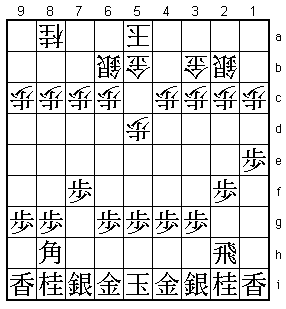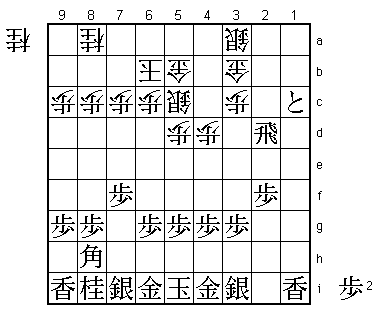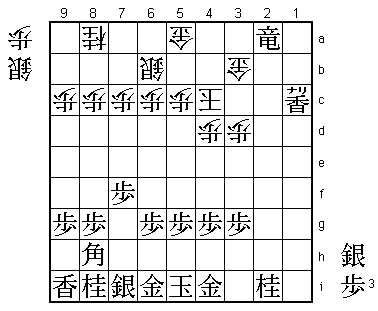

FIVE PIECE HANDICAP (remove rook, bishop, both lances and either knight) is rarely played, and when it is played normally white’s right hand knight is removed. This is because black’s rook and bishop both point to white’s left, so he will surely choose to keep his left knight to defend the weaker side.
However for a player who has just graduated from six piece it is a very large step to five piece right, so it is reasonable to insert five piece left (meaning left knight removed) as an intermediate handicap. In any case, the lessons in this article will be vital to understanding the lesser handicaps, especially four piece.
The strategy I recommend for black is to play either a knight attack or a climbing silver attack, the latter if white advances his "2" pawn. These are two of the most fundamental attacking plans in shogi, so it will pay to study this article even if you never play this handicap.
Play will normally go 1... S6b (white moves towards the side where he expects the attack to come) 2 P7f (one book recommended 2 P5f, 3 S7h, and 4 B7i but I think the text is best) G3b 3 P2f S2b 4 P1f (leaving the 2e square open for his knight). Now white must decide whether to develop or to defend.
Normal development would go 4... P5d 5 P1e G5b

After 5... G5b
6 N1g (This plan is suggested for six piece handicap in Kimura Meijin’s famous old book "Shogi Taikan", and it seems even more appropriate for five piece left. The knight move to the edge only makes sense if it goes to 2e quickly; as in chess, knights don’t belong on the rim.
The alternative plan of 6 P2e K4b 7 L1g K3a 8 R1h K2a isn’t as easy as it looks, because 9 P1d? Px1d 10 Lx1d ? P*1c 11 Lx1c+ Sx1c 12 Rx1c+? L*1b traps the dragon!
Or, white can answer 6 P2e by G5c 7 L1g G4d 8 R1h G3d 9 P1d Px1d 10 Lx1d Gx2e 11 L1b+ P*1f keeping the rook out)
6... S5c 7 N2e P4d (7... P2d 8 Nx1c+ Sx1c 9 P1d S2b 10 P1c+ S3a 11 P2e Px2e 12 Rx2e P*2b 13 P*2c wins easily) 8 R1h! P2d (else 9 P1d and black breaks through for free) 9 Nx1c+ Sx1c 10 P1d S2b 11 P1c+ S3a (the sacrifice of knight for pawn to promote a pawn is about even materially, but black will soon promote his rook and make further gains) 12 R1d K6b 13 Rx2d intending R2a+ and +P2c.

After 13.Rx2d
White may prevent the above plan by an early ... P2d and ... G2c, which also stops the L1g and R1h plan. However the pawn sticking out on 2d provides black a target for a "climbing silver" attack, the most basic attack in shogi.
4... K4b 5 P1e P2d 6 S3h G2c (if 6... S2c black can just play L1g and R1h) 7 S2g P3d 8 S3f S3c (note that without the king on 4b black could now play 9 P1d Px1d 10 Lx1d) 9 P2e Px2e 10 P1d! (the key move of the line, giving the silver a target) Px1d 11 Sx2e P*2d 12 Sx1d G2b (or 12... Gx1d 13 Lx1d P5d 14 L1c+ with +L2c next) 13 S1c+ G3b 14 +S1d P4d 15 +Lx2d Sx2d 16 Rx2d K4c 17 R2a+ G5a 18 L1c+ intending P*2d and P2c+ next.

After 18.L1c+
It is really easy to win at this handicap with the above lines; the remaining handicaps are not so simple.
Lessons from this handicap :